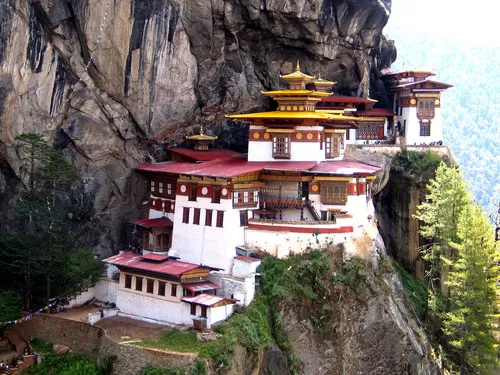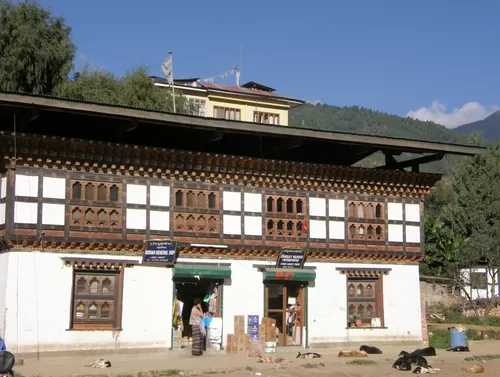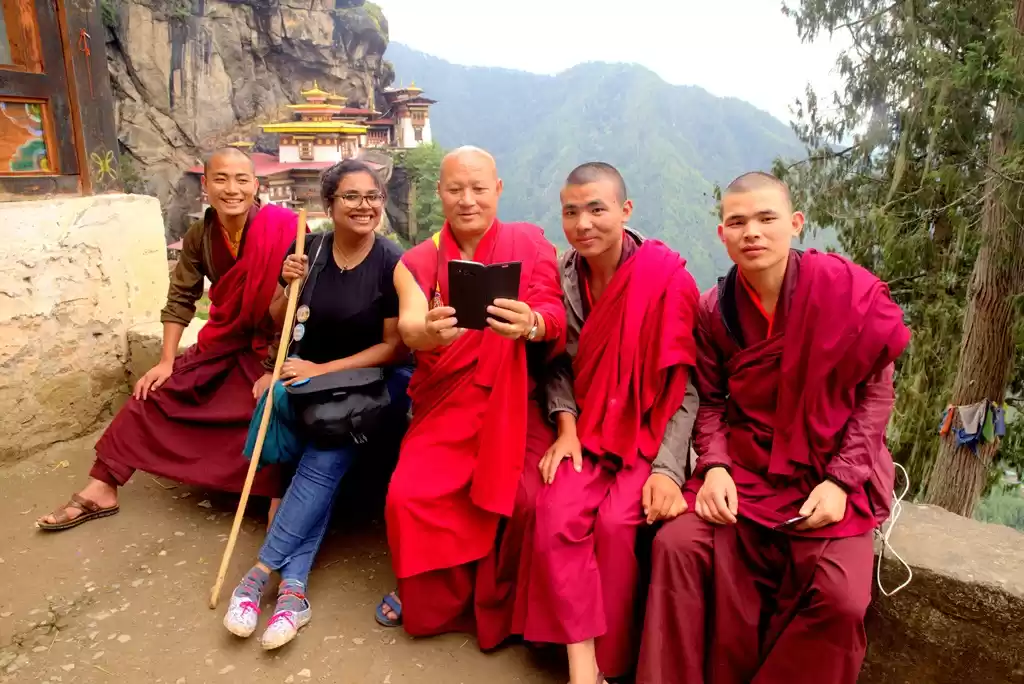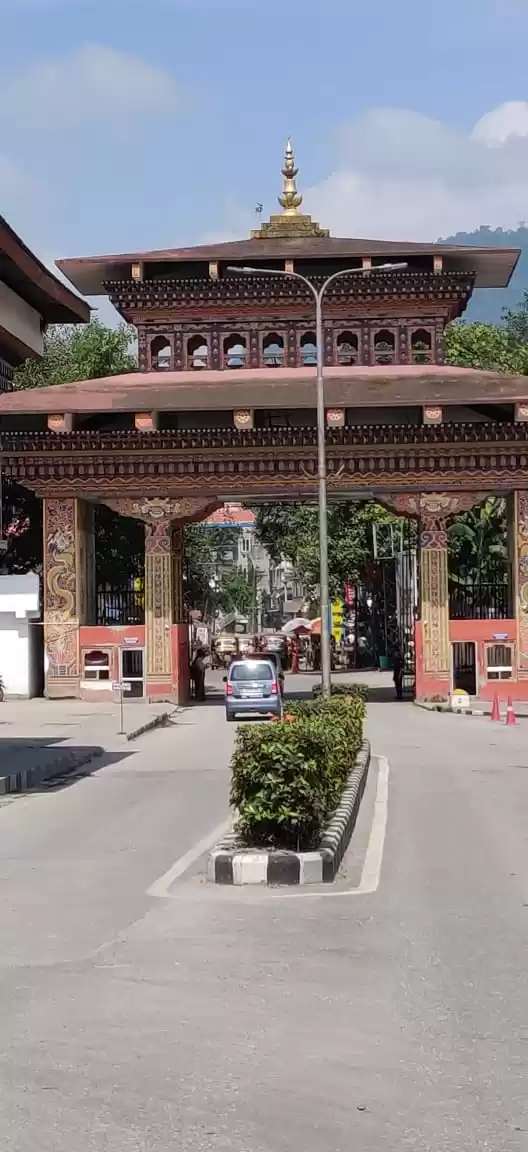









When my sister and I signed up for the WoW (women of wonderlust) club to travel to the kingdom of Bhutan, little did we know that it would change our lives forever. Before even the idea could sink in, we were meeting and greeting the 12 other women at the Kolkata International airport who would accompany us to the land of the Thunder dragon.
The flight to Paro from Kolkata is one of the most spectacular of all mountain flights. The first gift from Bhutan is the cool, clean fresh air and as we stepped out of the aircraft we were greeted by our travel guide and he quickly briefed us of what lay ahead.
We drove to Thimpu, the capital of Bhutan. The two hours drive was literally breathtaking, with the mountains heaving into the distance,silhouetted against the deep blue sky, through pristine landscapes. Thimphu is a lively place, an interesting combination of tradition and modern. We started our afternoon by visiting the local school of arts and crafts and a handicraft shop for paintings etc. There we had a chance to speak to the students who explained the 13 different forms of arts. On our way back, we stopped to check the National Library. The sun was setting early so we took a walk around the town & decided to call it a day.
The next day started with a visit to the National Memorial Chorten, built in 1974 to memorialize the 3rd King. Then we drove to the Radio Tower Station to enjoy the magnificent view of Thimpu town. We stopped to see the Takin, the national animal at the local zoo and visited a monastery & a nunnery.
My visit to Thimpu would have remained unfinished had I not seen the Tashichoedzong, seat of the Bhutanese government since 1952. Its one of the most beautiful pieces of architecture that I have ever seen. I had hoped to get a glimpse of the present king who visits the dzong everyday, but we missed him.
The day after, we left for Punakha. The Punakha valley was the capital city till 1961. The road to Punakha traverses through thick forests of blue pine, oak and maple. The valleys between ridges often have small rivulets and occasional waterfalls. Some of the rivulets have been harnessed for the spinning of prayer wheels. Inside this shed-like building is a single large wheel driven by the rivulet. A large chorten and prayer flags greets us at Dochu La, a pass at 10,300 ft. There is a small cafeteria just above the pass, which featured some of the most overpriced goods (running into hundreds of dollars).Punakha Dzong is, in my opinion, Bhutan's most attractive construction. At 600 ft long, the dzong houses as many as 600 monks.The dzong's location is at the confluence of the Mo Chu and the Pho Chu (literally, the mother and father rivers). The way till the Dzong is through a newly inaugurated wooden roofed cantilever bridge over the Mo Chhu river.The dzong has survived 6 fires, 2 glacial lake bursts, and 1 earthquake. The design for the Dzong was never put on paper or sketched, and yet the architecture is breathtaking. It features the same bright exterior and interior artwork seen throughout Bhutan.
We spent the last two nights in the Dragon Kingdom at Paro. The drive back to Paro was 4 hours with two or three occasional stops. As the vehicle sped through the beautiful road I could'nt help but notice the lovely forests of rhododendron. On the way we hiked to Chhimi Lhakang (Temple of fertility) through the beautiful paddy fields. The temple is dedicated to Drukpa Kuenley, who was a favorite saint of the Bhutanese people and is known affectionately as "the Divine Madman".
Our visit to Bhutan was concluded with a hike to the magical monastery known as Taktsang (the "Tiger's Nest"). Taktsang is one of the most sacred pilgrimage sites in the Himalayan World. The monastery itself is perched on a granite cliff that drops 2,000 feet to the valley floor. The path takes us through a forest of oak, blue pine and rhododendron, arriving at a small chorten surrounded by prayer flags. We hiked for 4.5 hours to reach all the way up. Little did I know that my dream of witnessing paradise on earth will come true when I stood on the farthest point of the temple and witnessed two rainbows in the horizon. The experience was just out of the world!
Hidden above the clouds and encircled by the rugged mountains, abode to the humming Buddhist monks clasping on to an ancient religious lifestyle and perched on the most superlative mountain range in the world - the Kingdom of Bhutan haunts you days after you have visited it but once you experience it, you become part of it!
(Reposted from one of my earlier publications)
Frequent searches leading to this page
Bhutan tour packages price, Bhutan tourism for Indian, Bhutan tour package cost, Bhutan tour plan, Bhutan tours and travels, Bhutan trip cost
Thimphu is a lively place, an interesting combination of tradition and modern. The air is crisp and clean, the streets spotless without a single trace of plastic or garbage, there are no signs of hoardings, vehicles don’t honk, the forests are lush green and thick with pines, rhododendrons and maples and the people are warm, friendly and courteous. It’s refreshing from the word go.Visit the local school of arts and crafts where you can speak to the students who will explain the 13 different forms of arts. Also check the National Library which features the world's largest book.

Punakha is a beautiful valley, north of Thimpu, and is the winter home of the Central Monk Body.The Punakha Dzong, is a majestic fortress built at the confluence of two rivers, the clear blue “female” river Mo Chu and the white “male” river Pho Chu.A bridge across the river takes you into this historical site where the 1st king of Bhutan was coronated. Inside the Dzong, you will see large courtyards, with temples and doors made of wood and iron. Check for the numerous apple orchards along the edge of the road all the way from Thimpu to Punakha.

We took a 40-minute hike through rice fields to arrive at the Chimi Lhakhang Temple, which was built by Lama Drukpa Kuenley, who is also known as the Divine Mad Monk.This temple is known as the Temple of Fertility and as we went inside, the head monk blessed us with a wooden phallus, which is the symbol of fertility. You must visit this mostly because of the walk through the paddy fields. Very refreshing.


Trekking to Taktsang is an experience of a lifetime and all of us in the group vowed to be back again someday. It is believed that this sacred monastery was founded by Guru Rimpoche who flew on the back of a flaming tiger in the 8th century and meditated in a cave for three months at this site.Located at 2,950 metres above sea level, this is the most famous and the only hanging cliff monastery in Bhutan. The hike itself is at once challenging and fulfilling. We walk for almost 4 hours to be confronted by 1000 more steps that would give any sane person a vertigo. But the adrenaline is so much that you cannot help but continue. The monastery stands gleaming in its white exterior with red adornments and a gold cupola roof, looking strikingly spiritual.


As the name suggests the view from the room is like a perfect wallpaper with lush green mountains and the gently flowing Thimpu Chu river set amidst white glistening stupas.Just like in most spots of Bhutan, the view is that of simple, untouched beauty. The hotel serves traditional lunch which is a delightful affair of delicious, home-made preparations of mushrooms, red rice, mixed vegetables and the quintessential Bhutanese dish called Ema Datsi or chilli and cheese.

Literally a Palace converted into a Hotel, this was beautiful architecture, with a stunning view from each room and the meditative feeling of Bhutan seeping through its walls. The service was superb and the general feel of the place truly relaxing. They offer traditional stone baths that are a wonderful treat after climbing to Tigers Nest. The view from the hotel, overlooking Paro, is lovely, especially at night when the Dzong is drenched in floodlight.

A trip to Thimpu can’t be complete without spending at least one evening at the Thimpu Square. Dotted by cafes and shops selling everything from trinkets and handicrafts to everyday household items, Thimpu Square is a haven for tourists, who compare notes and give each other knowing nods. Though nobody really seems to be in a rush, there is a clock-tower right in the centre of the square.Bhutanese stamps have always had a place of pride in our amateur philately albums, so a visit to the Bhutan General Post Office, which is a stone’s throw from the Square, is also recommended.
Frequent searches leading to this page
Bhutan tour packages price, Bhutan tourism for Indian, Bhutan tour package cost, Bhutan tour plan, Bhutan tours and travels, Bhutan trip cost

Frequent searches leading to this page:-
Bhutan tour packages price, Bhutan tourism for Indian, Bhutan tour package cost, Bhutan tour plan, Bhutan tours and travels, Bhutan trip cost




































